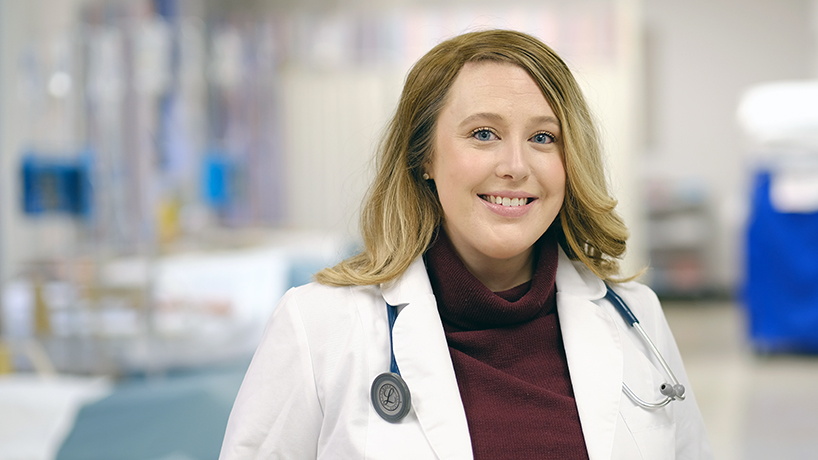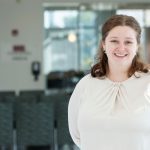
College of Nursing alumna Kelly Lucash investigated pediatric fluoride applications for her DNP clinical scholarship project. (Photo by August Jennewein)
It took one phone call for Kelly Lucash to decide that the University of Missouri–St. Louis was the school for her. The now-College of Nursing alumna had been halfway through a different family nurse practitioner program, but something wasn’t quite right. So she reached out to UMSL to see if her credits might transfer.
Later the same day, Lucash got that fateful call from then-DNP Program Director Roberta Lavin.
“Just hours later, she had a plan of study for me,” Lucash said. “I applied, and the rest is history. Having that conversation on that first day with someone so high up in nursing administration who was willing to talk to some random student on the phone made me feel like this would be a good fit because that’s a lot of what I had been missing.”
That wasn’t the only revelation Lucash had thanks to nursing administrators. The second came from Lavin’s successor, the current DNP Program Director Laura Kuensting. Noticing Lucash’s background in the neonatal intensive care unit, Kuensting suggested she switch into the pediatric nurse practitioner program. That made sense to Lucash, who once again appreciated the time and care that the nursing faculty took with her.
Those dual experiences ended up defining Lucash’s career and, in turn, the patient populations she will impact as a practitioner. There’s no place that’s more evident than in an opportunity Lucash had last year to study abroad in Guatemala.
The trip, which took place over winter break, was the College of Nursing’s inaugural excursion in what has become a biannual study abroad trip serving six native communities. Though Lucash was initially nervous to spend a week with classmates she knew mostly from online classes, she grasped onto the opportunity to work face-to-face with then-Assistant Teaching Professor Lisa Merritt.
“That was really special,” Lucash said. “We were the only two pediatric nurses on the trip, so we worked it so that I could see all the pediatric patients, which was really helpful. I hadn’t done clinical hours with her – she teaches the classroom portion – but it was rewarding to have her there watching me in practice.”
It was moments like those that reinforced Lucash’s decision to switch her studies to pediatrics. She carried her conviction into her DNP clinical scholarship project, “Implementation of Oral Health Recommendations in Pediatric Primary Care,” which examined new pediatric fluoride applications in a Mercy clinic.
Though the American Academy of Pediatrics recommends children start seeing a dentist by 12 months old, many don’t until much later because of a shortage of pediatric dentists. To prevent cavities during that time, Mercy began recommending that primary care providers apply a fluoride varnish before the age of 5. Lucash tackled this new recommendation for Mercy Clinic Pediatrics – Sunset Hills – where she did her clinicals.
She investigated if there were a difference in follow-through for the recommendation between medical doctors and advance practice registered nurses and the average reimbursement rate.
Lucash started by thinking practically. She decided to focus on patients up to 3 years old because after that time, they tend to see a dentist. Then, to make it easier to remember for the practitioners, Lucash decided to do the application during routine well-child checks: 12 months, 18 months, 24 months and 36 months.
“I did research to see how it had been successfully implemented at other offices,” Lucash said. “There’s evidence that children who receive at least four fluoride applications by age 3 have a reduction in cavities and untreated dental decay.
She arranged for a medical sales representative to do education with the doctor, nurse practitioner and office manager and the office manager ordered the fluoride varnish.
“The whole office was receptive,” she said. “But what I learned is having providers sit down in a meeting and tell you, ‘Yeah, I like this idea’ and then having them implement it was actually quite different.”
Lucash set her test period from April 1 to May 15 last year. Of the 47 patients the clinic’s nurse practitioner saw during that period, she applied fluoride to the teeth of 25 patients. The doctor, on the other hand, only treated two of 56 patients with fluoride. Combined, the clinic just exceeded their goal of having 25 percent of patients receive the treatment during the first six weeks after implementation.
Of those treated patients, Medicaid covered the costs of 89 percent of patients, private insurance covered 4 percent and the remainder were uninsured. That added up to a total of $413 in revenue for the clinic, and Lucash estimated the potential net revenue for the clinic could be $3,200 annually.
Lucash biggest takeaway were the skills she learned throughout her project.
“As a nurse practitioner, one thing that I will have to do for the rest of my life is stay up to date with guideline changes or practice changes,” she said. “My project made me walk through from start to finish taking new guidelines, reading through them, understanding them, implementing them and looking at how we’re doing. I think this was the perfect way for me to complete a project right before I graduate and go into practice because it was so relevant to what I’ll need to do outside of diagnosing and managing. Now I have leadership skills that will be relevant.”
For the moment, Lucash remains at work at the NICU but she’s looking for a job as a pediatric nurse practitioner. Last year she taught undergraduate pediatric clinicals at UMSL, which fits in with another long-term desire: giving back.
“I’m passionate about educating patients and making sure they understand what it is they have to know,” she said. “But one of the reasons I came back to school was I would like to teach in the future. I’d like to pass on my knowledge.”














